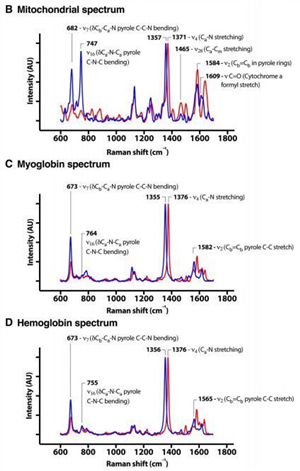On September 20th, STM magazine cover article reported that US scientists have developed a new device that can assess whether body tissue has enough oxygen in real time to predict cardiac arrest in critically ill patients. This is the first time that Raman spectroscopy has been developed as a clinical medical device for real-time monitoring. The industry believes that there are important milestones. (This article Source: Bio-Exploration)

Place the probe on the heart during surgery or after surgery to predict cardiac arrest in critically ill patients. This is a new device developed by researchers at Boston Children's Hospital and Pennar technical equipment manufacturers. Raman spectroscopy technology enables real-time assessment of whether body tissue is getting enough oxygen.
On September 20th, the cover article of ScienceTranslational Medicine published the results of this research, and believed that although the research was carried out on animal models, it has important milestones.
1. Milestone
Almost everyone knows that for patients with critical heart disease, once a cardiac arrest occurs, even if the patient recovers, the adverse consequences are lifelong.
However, because it is impossible to assess whether the body tissue is getting enough oxygen in real time, the previous technique can not effectively predict that a patient's heart will stop. The current standard for tissue oxygen measurement, known as mixed venous oxygen saturation (SvO2), requires repeated blood draws to increase the risk of critically ill patients. More importantly, it is impossible to determine whether the oxygen supply meets the dynamic needs of the heart muscle.
John Kheir, MD, of the Boston Children's Hospital Heart Center who led the study, said the newly developed device uses resonance Raman spectroscopy to measure whether enough oxygen reaches the heart's mitochondria. This device provides organ-specific, continuous, and reliable readings related to mitochondrial oxygen supply. This is the first device to monitor mitochondria in living tissue to predict impending organ failure.
This is the first time that Raman spectroscopy has been developed as a clinical medical device for real-time monitoring.
As a non-destructive, non-contact rapid detection technology, although the application and research of Raman spectroscopy in medical diagnosis has been carried out in the fields of cancer lesion detection and diagnosis, blood component analysis, and arteriosclerosis detection. In addition, the previous application in medical diagnosis was achieved by analyzing the differences in Raman spectral peaks associated with proteins, nucleic acids, and blood lipids in tissues, and this application focused on spectral shifts and peak changes caused by finer electron accumulation. And accurately capture the signal of the subcellular structure.
2. Monitor mitochondria with light
In this study, the research team created a metric called 3RMR that uses the optical readings of the resonant Raman spectroscopy to generate real-time oxygen content and metrics for quantifying mitochondrial function.
When the oxygen content of a cell is too low, its energy balance changes. Electrons begin to accumulate in certain cellular proteins such as hemoglobin, myoglobin, and mitochondrial cytochromes. This energy transfer reduces or disables the production of mitochondrial energy and may also cause cell death. The result is organ damage or dysfunction, and in the worst case, cardiac arrest.
Resonance Raman spectroscopy quantifies the electronic portion of mitochondrial proteins by how the light scatters during laser irradiation. Under hypoxic conditions, an increase in electrons can distort these molecules and change their spectrum.
The team also used precise lasers and sophisticated algorithms to extract information in real time. According to the introduction, high-speed and accurate identification of mitochondrial signals from other biological signals is the most important scientific advancement of this article.

Displacement and peak changes in mitochondrial cytochromes, myoglobin, and hemoglobin in the oxygenation and deoxygenation pull-down spectra.
3, predict cardiac arrest
The researchers first tested the device in a rat model. They found that regardless of the cause of the reduced oxygen delivery, the 3RMR increased accordingly after reducing the oxygen content of the heart. Measurements were taken 10 minutes after the hypoxic state and the reading increased by more than 40%. The devices they developed were 97% specific and 100% sensitive in predicting cardiac contractility and subsequent cardiac arrest, superior to all other measurement techniques.
The team further tested the device in a pig model that simulated congenital heart surgery. They were able to measure the satisfaction of myocardial oxygen supply, something that was not possible with previous equipment.
The first possible application of the device is oxygen delivery monitoring during and after cardiac surgery. The current probe is a pen size, but in the end, the team hopes to develop a smaller probe that can be placed in the chest to monitor patients in high-risk situations.
4. Other application directions in the future
In fact, this is the first technique to assess whether sputum delivers enough oxygen to the tissue at the mitochondrial level in real time. Researchers believe there will be many surgical uses. They believe that the technology can also monitor tissue viability in other tissue and organ exposure operations. Potential applications may include monitoring during organ transplantation and detecting reductions in blood flow to the extremities.
Dr. Kheir also believes that the tool can help in cancer research because mitochondrial function is the center of cancer biology.
The team's goal is to develop an FDA-approved and commercialized mitochondrial oxygenation clinical monitor. During this time, Dr. Kheir and colleagues plan to seek approval of the test device to monitor patients with heart disease.
References: 1) Responsive monitoring of mitochondrial redox states in heart muscle predicts impending
2) Laser device placed on the heart identifies insufficient oxygenation better than other measures
3) Raman spectroscopy for medical diagnostics — From in-vitro biofluid assays to in-vivo cancer detection
Violin Practice Room,Portable Soundproof Vocal Booth,Private Vocal Booth,Portable Soundproof Office Room
Guangzhou Mingli Intelligent Equipment Co.,Ltd , https://www.minglibooth.com